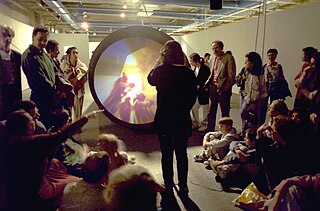Definition
Virtual art can be considered a post-convergent art form based on the bringing together of art and technology, thus containing all previous media as subsets. [5] Sharing this focus on art and technology are the books of Jack Burnham (Beyond Modern Sculpture 1968) and Gene Youngblood ( Expanded Cinema 1970). Since virtual art can consist of virtual reality, augmented reality, or mixed reality, it can be seen in other aspects of production such as video games and movies.
In his book, From Technological to Virtual Art, Frank Popper traces the development of immersive, interactive new media art from its historical antecedents through today's digital art, computer art, cybernetic art, multimedia art, and net art. Popper shows that contemporary virtual art is a further refinement of the technological art of the late twentieth century and also a departure from it. What is new about this new media art, he argues, is its humanization of technology, its emphasis on interactivity, its philosophical investigation of the real and the virtual, and its multisensory nature. [6] He argues further that what distinguishes the artists who practice virtual art from traditional artists is their combined commitment to aesthetics and technology. Their "extra-artistic" goals – linked to their aesthetic intentions – concern not only science and society but also basic human needs and drives. [7]
To explain and illustrate the emergence of a techno-aesthetic, Popper stresses the panoramic and multi-generational reach of virtual art. As regards to virtual art, openness is stressed both from the point of view of the artists and their creativity and from that of the follow-up users in their reciprocating thoughts and actions. This commitment to the teeming openness found in virtual art can be traced to the theories of Umberto Eco and other aestheticians.

Cyberspace is a concept describing a widespread interconnected digital technology. "[The expression dates] from the first decade of the diffusion of the internet. It refers to the online world as a world 'apart,' as distinct from everyday reality. In cyberspace people can hide behind fake identities, as in the famous The New Yorker cartoon ..." The term entered popular culture from science fiction and the arts but is now used by technology strategists, security professionals, governments, military and industry leaders and entrepreneurs to describe the domain of the global technology environment, commonly defined as standing for the global network of interdependent information technology infrastructures, telecommunications networks and computer processing systems. Others consider cyberspace to be just a notional environment in which communication over computer networks occurs. The word became popular in the 1990s when the use of the Internet, networking, and digital communication were all growing dramatically; the term cyberspace was able to represent the many new ideas and phenomena that were emerging.

Interactive art is a form of art that involves the spectator in a way that allows the art to achieve its purpose. Some interactive art installations achieve this by letting the observer walk through, over or around them; others ask the artist or the spectators to become part of the artwork in some way.
Telepresence refers to a set of technologies which allow a person to feel as if they were present, to give the appearance or effect of being present via telerobotics, at a place other than their true location.

Electronic art is a form of art that makes use of electronic media. More broadly, it refers to technology and/or electronic media. It is related to information art, new media art, video art, digital art, interactive art, internet art, and electronic music. It is considered an outgrowth of conceptual art and systems art.
Information art, which is also known as informatism or data art, is an emerging art form that is inspired by and principally incorporates data, computer science, information technology, artificial intelligence, and related data-driven fields. The information revolution has resulted in over-abundant data that are critical in a wide range of areas, from the Internet to healthcare systems. Related to conceptual art, electronic art and new media art, informatism considers this new technological, economical, and cultural paradigm shift, such that artworks may provide social commentaries, synthesize multiple disciplines, and develop new aesthetics. Realization of information art often take, although not necessarily, interdisciplinary and multidisciplinary approaches incorporating visual, audio, data analysis, performance, and others. Furthermore, physical and virtual installations involving informatism often provide human-computer interaction that generate artistic contents based on the processing of large amounts of data.
Knowbotic Research is a German-Swiss electronic art group, established in 1991. Its members are Yvonne Wilhelm, Christian Hübler and Alexander Tuchacek. They hold a professorship for Art and Media at the University of the Arts in Zurich.

Scott Fisher is the Professor and Founding Chair of the Interactive Media Division in the USC School of Cinematic Arts at the University of Southern California, and Director of the Mobile and Environmental Media Lab there. He is an artist and technologist who has worked extensively on virtual reality, including pioneering work at NASA, Atari Research Labs, MIT's Architecture Machine Group and Keio University.

Joseph Nechvatal is an American post-conceptual digital artist and art theoretician who creates computer-assisted paintings and computer animations, often using custom-created computer viruses.

Frank Popper was a Czech-born French-British historian of art and technology and Professor Emeritus of Aesthetics and the Science of Art at the University of Paris VIII. He was decorated with the medal of the Légion d'honneur by the French Government. He is author of the books Origins and Development of Kinetic Art, Art, Action, and Participation, Art of the Electronic Age and From Technological to Virtual Art.

Immersion into virtual reality (VR) is a perception of being physically present in a non-physical world. The perception is created by surrounding the user of the VR system in images, sound or other stimuli that provide an engrossing total environment.
Ebon Fisher is a pioneer of transmedia art, working at the intersection of art, biology and digital media. Informed by his exposure to cybernetics and feedback systems at the MIT Media Lab in the mid-1980s, Fisher has approached his work as an evolving collaboration with the world, culminating recently in a nervelike system of ethics conveyed through a transmedia world called The Nervepool.

Oliver Grau is a German art historian and media theoretician with a focus on image science, modernity and media art as well as culture of the 19th century and Italian art of the Renaissance. Main Areas of Research are: Digital Art, Media Art History, immersion, digital humanities, documentation and conservation strategies of born-digital media art. He is founding director of the Archive for Digital Art (1998) and director of the Society for MediaArtHistories and its biennial conference series. His monograph "Virtual Art: From Illusion to Immersion" is among the most cited works in recent art history, with over 2600 citations, and with translations of his texts in 15 languages to date and over 300 invited lectures in 44 countries, he is one of the most internationally renowned contemporary art and media scholars.

Pascal Dombis is a digital artist who uses computers and algorithms to produce excessive repetition of simple processes.

Hybrid art is a contemporary art movement in which artists work with frontier areas of science and emerging technologies. Artists work with fields such as biology, robotics, physical sciences, experimental interface technologies, artificial intelligence, and information visualization. They address the research in many ways such as undertaking new research agendas, visualizing results in new ways, or critiquing the social implications of the research. The worldwide community has developed new kinds of art festivals, information sources, organizations, and university programs to explore these new arts.
Virtuality is a concept in philosophy elaborated by French thinker Gilles Deleuze.

New media art includes artworks designed and produced by means of electronic media technologies, comprising virtual art, computer graphics, computer animation, digital art, interactive art, sound art, Internet art, video games, robotics, 3D printing, and cyborg art. The term defines itself by the thereby created artwork, which differentiates itself from that deriving from conventional visual arts. New Media art has origins in the worlds of science, art, and performance. Some common themes found in new media art include databases, political and social activism, Afrofuturism, feminism, and identity, a ubiquitous theme found throughout is the incorporation of new technology into the work. The emphasis on medium is a defining feature of much contemporary art and many art schools and major universities now offer majors in "New Genres" or "New Media" and a growing number of graduate programs have emerged internationally. New media art may involve degrees of interaction between artwork and observer or between the artist and the public, as is the case in performance art. Yet, as several theorists and curators have noted, such forms of interaction, social exchange, participation, and transformation do not distinguish new media art but rather serve as a common ground that has parallels in other strands of contemporary art practice. Such insights emphasize the forms of cultural practice that arise concurrently with emerging technological platforms, and question the focus on technological media per se. New Media art involves complex curation and preservation practices that make collecting, installing, and exhibiting the works harder than most other mediums. Many cultural centers and museums have been established to cater to the advanced needs of new media art.

Nicole Stenger is a French-born American artist, pioneer in virtual reality and Internet movies. In 1989 to 1991, she was a research fellow at MIT. In 1991 to 1992, she was a visiting scholar at the Human Interface Technology Laboratory (Hitlab) in Seattle. Her works have been featured in the SIGGRAPH Art Show, the FILE Festival, the JavaMuseum, the Cartier Art Foundation and are part of the Archive of Digital Art (ADA). In 2013, she was included in the "Contemporary women artists on the web" collection of the National Museum of Women in the Arts, in Washington, D.C. To this day, Stenger is considered to be one of the first artists to explore the artistic virtual reality medium.
Cybernetic art is contemporary art that builds upon the legacy of cybernetics, where feedback involved in the work takes precedence over traditional aesthetic and material concerns. The relationship between cybernetics and art can be summarised in three ways: cybernetics can be used to study art, to create works of art or may itself be regarded as an art form in its own right.
Adrianne Wortzel is an American contemporary artist who utilizes robotics in her installations and performances. She has also created many online works.
Media art history is an interdisciplinary field of research that explores the current developments as well as the history and genealogy of new media art, digital art, and electronic art. On the one hand, media art histories addresses the contemporary interplay of art, technology, and science. On the other, it aims to reveal the historical relationships and aspects of the ‘afterlife’ in new media art by means of a historical comparative approach. This strand of research encompasses questions of the history of media and perception, of so-called archetypes, as well as those of iconography and the history of ideas. Moreover, one of the main agendas of media art histories is to point out the role of digital technologies for contemporary, post-industrial societies and to counteract the marginalization of according art practices and art objects: ″Digital technology has fundamentally changed the way art is made. Over the last forty years, media art has become a significant part of our networked information society. Although there are well-attended international festivals, collaborative research projects, exhibitions and database documentation resources, media art research is still marginal in universities, museums and archives. It remains largely under-resourced in our core cultural institutions.″











